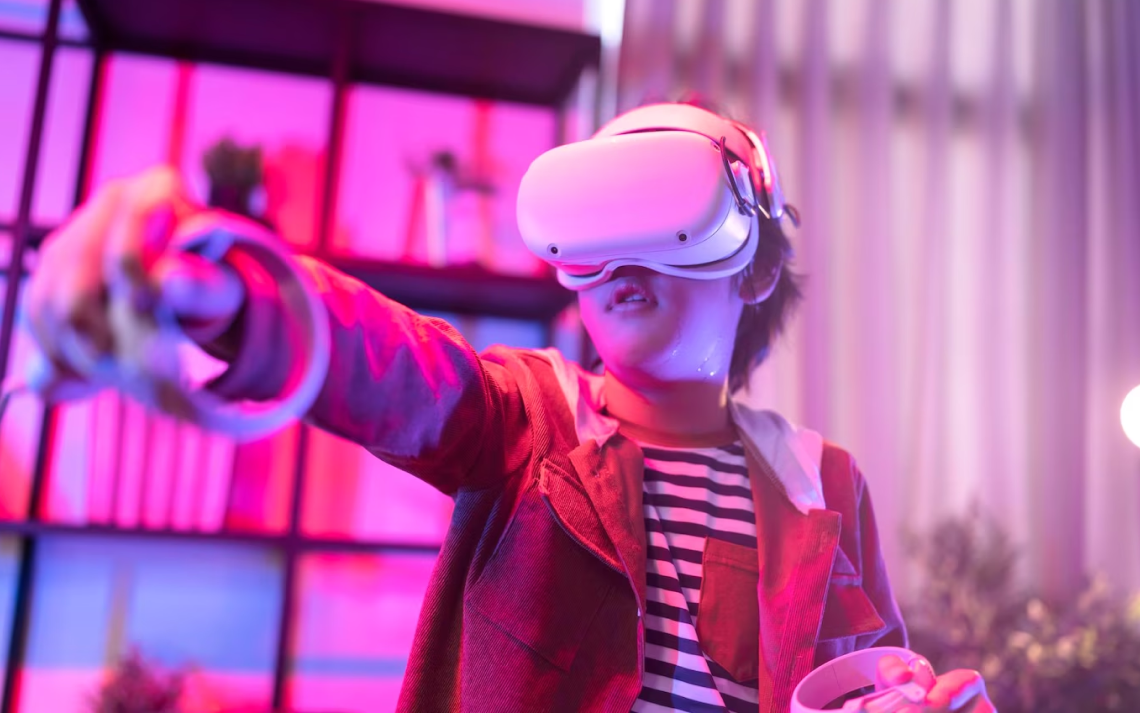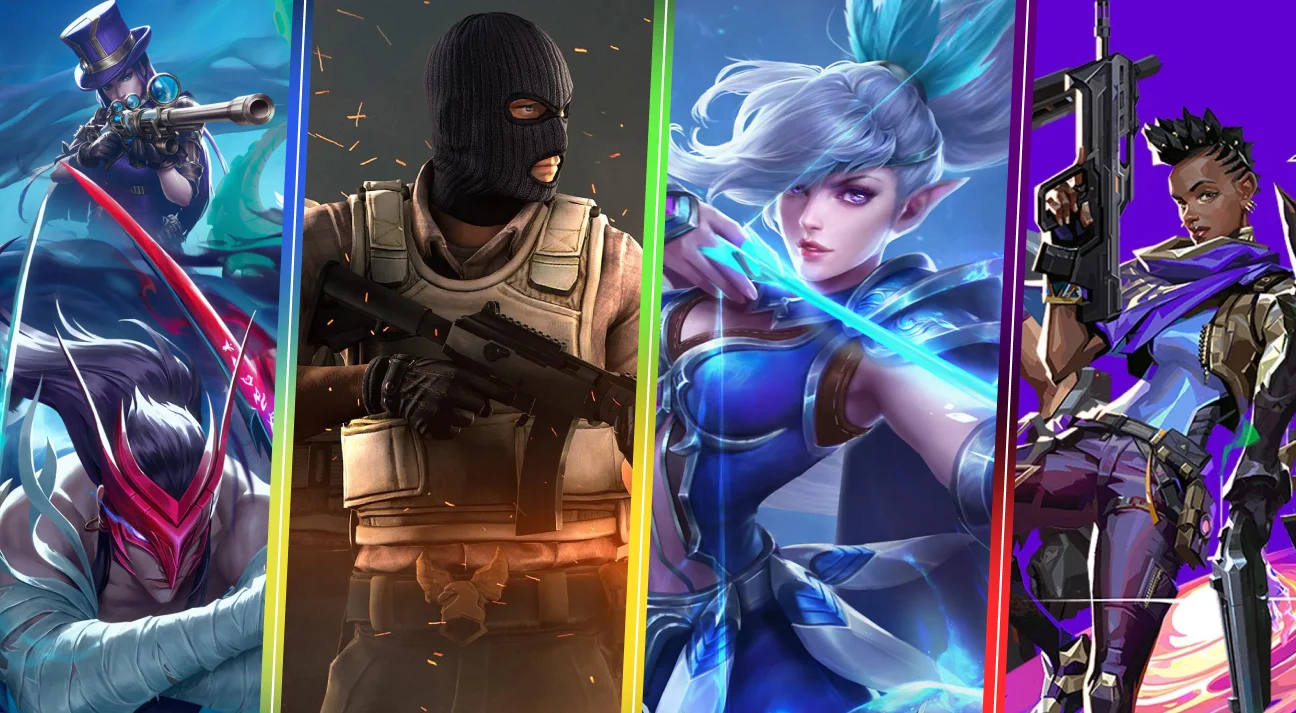
Metaverse in Gaming – How It Is Powering The Game Industry
Back when we were playing Fortnite – did we ever think – that this game could take place in Metaverse? But it is happening for real!
Many researchers and game enthusiasts believe that the metaverse in gaming is already here, and Fortnite is a great example of it, taking its steps closer to the metaverse with the help of the latest Unreal Editor for Fortnite (UEFN) update.
So, if Fortnite – like a big gaming giant – can see the metaverse’s potential for their star game, why can’t you? As per the GamesBeat Summit, around 52% of US gamers see potential in the metaverse changing the gaming industry.
In fact, these days, gaming is not just about entertainment; it has expanded to the source of earning money. Quite a lucrative option for all the fierce gamers! But have you ever tried to figure out the mechanics behind the doors of this current advanced gaming industry? Well, amazingly, the metaverse has a lot to do with it. Today, we are brewing a hot topic for you all to have insightful sips of facts about the metaverse.
You will definitely see the concept of the metaverse with a different outlook after reading this article. So, let’s learn how the Metaverse is doing a wonderful job of taking the gaming industry to the next level.
- What is Metaverse?
- How is the Metaverse Empowering the Game Industry?
- Market Overview of Metaverse Gaming
- 4 Technologies Behind the Glory of the Metaverse
- Surprising Benefits of Metaverse Game Development
- 5 Critical Challenges Game Development Companies Face While Adopting Metaverse
- Metaverse in Gaming – Is The Future Bright?
- An All-inclusive Guide to Creating a Metaverse Game
- How Can 300Mind Help You With Metaverse Game Development?
- FAQs on Metaverse in Gaming Industry
What is Metaverse?

The Metaverse is a term that describes a virtual reality space or universe where users can interact with a computer-generated environment and other users in real-time. It is often depicted as a fully immersive and interconnected digital world that can be accessed through various devices, such as virtual reality headsets, augmented reality glasses, computers, and smartphones.
In the Metaverse, users can explore and navigate virtual environments, engage in social interactions with other users, create and customize their own virtual avatars, participate in various activities and experiences, and even conduct business transactions. It goes beyond traditional video games by incorporating elements of social networking, entertainment, education, commerce, and more.
The concept of the Metaverse has been popularized through science fiction literature, particularly in Neal Stephenson’s novel “Snow Crash” and Ernest Cline’s novel “Ready Player One”. However, the idea of a virtual universe where people can interact and engage in virtual experiences has been discussed and pursued by technologists, developers, and visionaries in the real world.
The development and realization of the Metaverse involve advancements in virtual reality, augmented reality, artificial intelligence, blockchain, and other technologies. Companies and organizations are actively working towards creating and shaping the Metaverse, aiming to provide users with highly immersive, interconnected, and engaging digital experiences that blur the boundaries between the virtual and physical worlds.
How is the Metaverse Empowering the Game Industry?

The metaverse aims to provide a more immersive gaming experience by combining virtual reality (VR), augmented reality (AR), and other technologies. Players can enter highly detailed and realistic virtual worlds, engaging their senses and creating a more captivating gameplay environment.
It fosters social interaction on a larger scale, allowing players to connect and engage with others from around the world. It transcends traditional multiplayer games by offering a persistent and interconnected virtual world where players can communicate, collaborate, compete, and form communities.
The Metaverse encourages user-generated content creation, giving players the tools and platforms to contribute to the virtual environment. Players can design and customize their own virtual assets, such as avatars, items, and environments, and even monetize their creations.
Also, the metaverse aims to break down barriers between different gaming platforms and devices, enabling seamless cross-platform play. Players can access the Metaverse from various devices, including gaming consoles, PCs, mobile devices, and VR headsets, and enjoy a consistent experience across these platforms.
It has introduced new economic models within the gaming industry. Through blockchain technology and cryptocurrencies, players can own and trade virtual assets, creating real-world economic value. This opens up opportunities for entrepreneurship, virtual businesses, and even virtual employment with the Metaverse.
The Metaverse allows for the integration of different game genres, mechanics, and experiences. It goes beyond traditional gaming by incorporating elements of social networking, education, entertainment, and other industries. Players can engage in a wide range of activities, from playing games to attending virtual events, exploring virtual marketplaces, and participating in virtual economies.
Market Overview of Metaverse Gaming
The Global Metaverse in Gaming Market is estimated to expand from USD 36.81 billion in 2022 to USD 710.21 billion at a CAGR value of 38.2% from 2022 to 2027.
Nearly $20 billion is projected to be invested in gaming-focused AR and VR technology over the next year or so. This is set to comprise 62% of all AR/VR investments. The development of other applications is expected to be much slower, with investments of $4 billion in training, $4 billion in industrial maintenance, and $3 billion in retail expected in 2024.
Gartner estimates that 25% of people worldwide spend at least an hour per day online for work, shopping, social networking, and entertainment. Metaverse-based products and services will be offered by at least 30% of organizations.
Given the figures we have seen here related to the Metaverse, there is a high likelihood of the Metaverse being one of the emerging concepts of the gaming industry.
4 Technologies Behind the Glory of the Metaverse
There are two virtual environments that are connected by a set of common interface standards and communication rules called the Metaverse. The most recent development has forced gaming companies to switch to Metaverse games or explore the Metaverse.
Let’s learn in detail about the technologies that have been empowering the metaverse.
Blockchain And Cryptocurrency
Blockchain technology has given a major contribution to the metaverse. With blockchain technology, the factor of decentralizing metaverse projects makes things a lot easier. The process of digitalizing collectability and interoperability along with digital proof of ownership is streamlined.
Well, these are a few of the many surprising advantages that can be leveraged by implementing blockchain technology in metaverse gaming.
In spite of the fact that blockchain caters to the technology portion, crypto assets are being exchanged for gaming assets, NFTs, and so on.
Internet Of Things (IoT)
One thing that the metaverse is very well known for is the realistic experience it offers; IoT plays a very huge role in that part. The metaverse is capable of collecting, obtaining, and utilizing data from the real world due to IoT.
By doing so, metaverse objects can change their behavior as per the weather or atmospheric conditions.
3D Reconstruction
3D applications are already a known practice in the world of the metaverse, but 3D construction is quite a cutting-edge technology and one of the trending concepts that have gained traction during the period of COVID-19. Most real estate companies have leveraged 3D construction to help their clients take a virtual tour of their properties.
To complement the existing Metaverse technologies, Metaverse technology has used 3D reconstruction.
AR and VR Technology
Metaverse development is backed by ever-amazing 3D experiences that are the magic done by AR and VR technology.
With visual elements and characters, augmented reality is capable of transforming the real world and can create an even more wonderful virtual gaming world. With brilliant mobile game development services, it has become quite an easy task for users to install the game on their smartphones or any other digital device and play it seamlessly.
Learning about the benefits of the metaverse in gaming industry for further information.
Surprising Benefits of Metaverse Game Development
Metaverse game development offers surprising benefits that can transform the gaming experience and create new opportunities for players. Here are some key advantages of metaverse game development:
1. Immersive and Interactive Experiences
Metaverse games provide highly immersive and interactive experiences that go beyond traditional gaming. Players can explore vast virtual worlds, interact with other players in real-time, and engage with a rich variety of activities, creating a deeply engaging and dynamic environment.
2. Social connectivity
Metaverse games foster social connections by enabling players to interact, collaborate, and compete with each other. They can form communities, join guilds, and participate in group activities, enhancing social engagement and creating a sense of belonging within the virtual world.
3. Expanded Opportunities for Creators
Metaverse games provide a platform for creators to unleash their creativity. Players can design and build their own virtual spaces, create custom avatars, develop unique gameplay experiences, and even monetize their creations. This empowers players to become active contributors to the metaverse ecosystem.
4. Real-World Integration
Metaverse games have the potential to integrate with the real world in various ways. This can include partnerships with real-world brands, virtual events that connect players with real-world experiences, or even applications in fields such as education, healthcare, and simulations.
5. High Rate on Investments
Since the metaverse is one of the emerging technologies of 2023, especially in the gaming industry. Many big tech giants are investing in the metaverse as the future is bright! So, there is a high chance that investments will bring huge profits to investors; investing in the metaverse in gaming is quite a lucrative option.
No matter how beneficial the concept of a metaverse is in gaming industries, there are always some challenges that a gaming company faces while integrating metaverse into the game development process.
5 Critical Challenges Game Development Companies Face While Adopting Metaverse
The metaverse world has a lot to serve for the game development industry, but implementing the same is not a cakewalk. Here are certain common challenges that game development companies face:
1. Providing interoperability
Interoperability raises concerns about protecting intellectual property rights. Game companies invest significant resources in creating unique characters, assets, and game mechanics. Allowing these elements to interact with other games or metaverse experiences may pose challenges in terms of ownership, licensing, and potential infringement issues.
The concept of metaverse has the involvement of many emerging technologies like virtual reality, augmented reality, and blockchain. These technologies may have different protocols, data formats, and interfaces, making it challenging for game companies to create a cohesive and interoperable metaverse experience.
Moreover, game development companies often develop games for various platforms such as PC, consoles, and mobile devices. Each platform has its own set of hardware, software, and standards, making it difficult to ensure interoperability across all platforms. Integrating different platforms into a unified metaverse experience can be technically complex and time-consuming.
2. Data Security
The metaverse involves the exchange of data and interactions between different systems. Ensuring security and protecting user privacy becomes paramount. Establishing robust security measures and privacy standards that can be universally adopted across different metaverse platforms is a complex task.
For customized features, gamers impulsively put their personal information which may trigger hackers to misuse their data. In such cases, gaming companies are held responsible for the failure of data protection from cyber criminals.
A data leak or a hacker attack might do irrecoverable damage to a metaverse game, especially considering the early stages of the technology adoption. NFT tokens and cryptocurrencies are also a source of additional risks in the game because players are operating real-world assets. To improve the security and protection of players’ data and assets, metaverse game developers need to enhance their security measures and protocols.
3. Infrastructure Breach
One of the biggest challenges companies face in the gaming Metaverse is the lack of interoperability and uniformity between the multiple Metaverse gaming platforms.
The scale of interoperability that is needed to create a desired gaming metaverse is not completely achieved by gaming companies. We still have a long way to go in terms of technological advancement, with major tech giants and patent holders collaborating, and different countries collaborating on a single metaverse law body that needs to be developed.
4. Token Economics
The connection that the in-game and real economies share is the prime factor that influences gamers and inclines their interest in metaverse gaming. But the challenge here is to set up a digital economy; it is a pretty complex task. It is because you have to determine financial parameters such as transaction fees, inflation models, governance, supply, and other relevant parameters.
These challenges prevent users from exploring the wondrous world of metaverse gaming. And some users who are ready to enter the world of metaverse gaming might struggle as they lack relevant experience.
That’s why, to win players’ loyalty and create positive word-of-mouth, metaverse gaming companies should focus on building user-friendly interfaces and mapping out superior user experiences.
5. Incorporating NFTs into gaming
NFTs in gaming play an essential role by allowing players to purchase in-game assets, such as themes, wardrobes, skins, players, powerups, etc., in a secure and total, immutable ownership manner.
NFTs can create a new source of income for the metaverse-enabled gaming industries. If NFTs are increasingly used in metaverse gaming, it can improve customer satisfaction and total transparency.
Despite the popularity of NFTs in gaming, it is still a relatively new technology with many technical challenges, where minting, transferring, storing, and managing NFTs can be a huge challenge. In addition to that, there’s still no specific economic model for NFT-based gaming.
Moreover, the NFT-related regulatory part is still evolving, making it difficult to follow a clear approach and best practices to launch and operate NFT-powered games.
Now that we have learned about the challenges that game developers come across while creating a metaverse game, let’s move forward with learning about the future of metaverse in the gaming industry.
Metaverse in Gaming – Is The Future Bright?
The future of the metaverse in the gaming industry holds tremendous potential and is likely to have a significant impact on how games are created, played, and experienced. Here are some key aspects of the future of the metaverse:
The metaverse will provide increasingly immersive and interactive experiences for gamers. Virtual reality (VR), augmented reality (AR), and mixed reality (MR) technologies will play a crucial role in creating more realistic and engaging gaming environments. Players will have the opportunity to fully immerse themselves in rich virtual worlds and interact with other players in real time.
It also enables seamless cross-platform interactions, allowing players to connect and engage with games and experiences regardless of the hardware or platform they are using. Players can move between different games and metaverse experiences, bringing their customized avatars, achievements, and virtual possessions with them.
Also, there is a high chance that the metaverse will enable seamless cross-platform interactions, allowing players to connect and engage with games and experiences regardless of the hardware or platform they are using. Players can move between different games and metaverse experiences, bringing their customized avatars, achievements, and virtual possessions with them.
The metaverse can offer unprecedented levels of immersion by creating virtual worlds that are highly realistic, interactive, and dynamic. With advancements in technology like virtual reality (VR) and augmented reality (AR), players can be fully immersed in gaming experiences, making them more captivating and engaging.
The metaverse has the potential to redefine what gaming means. It can blur the lines between virtual and physical realities, introducing new gameplay mechanics, experiences, and genres. The metaverse can incorporate elements from other industries such as entertainment, education, and commerce, leading to innovative and novel gaming experiences.
While the metaverse holds immense promise, it also presents challenges, including technical complexities, interoperability issues, and concerns related to privacy and security. Overcoming these challenges will be crucial for the metaverse to rock the gaming industry truly.
However, with ongoing advancements in technology and growing interest from both gamers and industry stakeholders, the metaverse has the potential to reshape the future of gaming.
An All-inclusive Guide to Creating a Metaverse Game
Let’s learn how to create a Metaverse game application with this all-inclusive guide. We are sure you will end up creating a marvelous game if you stick to following every single step that is mentioned here. Let’s get started:
Conduct in-depth market research
Market research helps you understand who your target audience is. It allows you to gather information about the demographics, preferences, and behaviors of potential players. This knowledge is crucial for designing a game that resonates with your target audience and meets their specific needs and desires.
Also, it helps you analyze the competitive landscape. It allows you to identify existing gaming apps that are similar to your concept and understand their strengths, weaknesses, and market positioning. This information helps you differentiate your game, identify unique selling points, and develop strategies to stand out in the market.
Conducting market research helps you set realistic goals and expectations for your gaming app. It provides insights into the market size, potential revenue, and competitive landscape, allowing you to make informed decisions about budgeting, marketing strategies, and long-term business plans. This information is crucial for setting achievable targets and developing a sustainable game development and marketing strategy.
By conducting thorough market research, you can increase the chances of creating a successful metaverse gaming app that resonates with players and achieves your business objectives.
Create a storyboard
A storyboard is a visual representation or a sequence of illustrations that depict the flow of gameplay, user interactions, and key events within the game. It serves as a blueprint or a visual outline for the development team, providing a clear understanding of how the game will progress and how different elements will come together.
A storyboard typically consists of a series of panels or frames that depict specific scenes, levels, or gameplay moments. Each panel may include visuals, descriptions, dialogue, and annotations to communicate the intended gameplay mechanics, user interface elements, character actions, and overall narrative progression.
So, it’s really important to create a storyboard to create a metaverse game successfully.
Pick a game engine
A game engine serves as a platform to create virtual worlds. The most common options are:
Unity is a cross-platform 3D game engine that most of the game developers use to create 2D, 3D, VR, and AR apps.
Epic Games’ Unreal Engine (UE5) is a gaming engine that game developers use to develop 3D games, interactive experiences, and virtual reality applications.
Godot is a cross-platform, open-source engine for developing 2D and 3D games.
Generate a virtual world
This step brings your metaverse game to life. Here’s how you can create a virtual world for the Metaverse game:
Define the theme, setting, and overall vision for your virtual world. Consider what makes it unique and engaging for players.
Determine the size and layout of your virtual world. Decide on the number of regions, areas, and landmarks within the world. Sketch out a basic map or diagram to guide your design.
Create the visual and audio assets for your virtual world. This includes 3D models, textures, animations, sound effects, and background music. Use specialized software such as 3D modeling tools and game engines to build and populate the environment.
Implement interactive elements such as non-playable characters (NPCs), quests, puzzles, and objects. These elements allow players to engage with the virtual world and each other.
Finally, Define the rules and mechanics that govern the virtual world. Determine how players can interact with the environment, what actions are possible, and any limitations or restrictions. Balance gameplay elements to ensure an enjoyable experience.
Integrate Blockchain in the Metaverse game
Research and select a suitable blockchain platform that aligns with your requirements. Ethereum is a popular choice due to its smart contract capabilities, but other platforms like Binance Smart Chain, Solana, or Flow might also be worth considering.
Then define the in-game virtual asset economy and create a token that represents ownership of these assets. Determine the supply, distribution, and utility of the tokens within your metaverse game. Consider factors like rarity, utility in gameplay, and potential for trading or staking.
After designing token economics, develop the smart contracts on the chosen blockchain platform. These contracts will define the behavior and rules governing the creation, ownership, transfer, and trade of virtual assets. You may need to engage blockchain developers or use existing frameworks and libraries to simplify the development process.
Post that, Integrate blockchain wallets into your metaverse game to enable users to securely store and manage their virtual assets. Consider using web-based wallets, browser extensions, or mobile wallets to provide a user-friendly experience. This integration allows players to interact with the blockchain and manage their digital assets seamlessly.
Lastly, provide clear instructions and tutorials to help players understand how blockchain integration works within your metaverse game. Educate them about the benefits and opportunities blockchain technology offers. Simplify the onboarding process to ensure a smooth user experience.
Remember that integrating blockchain into a metaverse game requires a deep understanding of both game development and blockchain technology. Collaborating with blockchain experts and proficient game developers can be valuable to ensure a successful implementation.
Test and Debug
Lastly, test your Metaverse game and debug it for users to have a smooth gaming experience. After QA engineers are done with their jobs, it’s time to launch the app for users to help them obtain an exceptional experience.
Wondering how much it costs to bring your gaming realm to life in Metaverse? Read this blog to know the cost of Metaverse game development.
How Can 300Mind Help You With Metaverse Game Development?
Games are no longer perceived as an option of entertainment after the arrival of the metaverse, they have become a source of finance. How amazing is the fact that technology has changed the whole outlook of the gaming industry of late; gamers surely have a long way to go!
But, being a game development company, you are always on the quest to create a game that raises the bar of entertainment and excellence. In such cases, we come into play!
We at 300Mind are known for helping our clients with our steadfast and excellent technical services. Our aim is to list you as our top clients and to be listed as the best game development company when it comes to choosing Metaverse game app development.

FAQs on Metaverse in Gaming Industry
The answer to this question totally depends on the game’s features, its complexity, and other relevant factors such as technology stack, location of the development team, team size, and so on.
It’s one of the most lucrative options for the gaming industry out there. As per the research done by Statista, worldwide revenue within the VR gaming content industry is estimated to grow from 1.8 billion U.S. dollars in 2020 to 6.9 billion U.S. dollars by 2025.
Although many are aimed at gamers, the concept can be applied to a wide range of industries. The social aspect of the metaverse primarily defines them; they bring people together within virtual settings. Despite what you might think, there’s much more to the metaverse than meets the eye.








